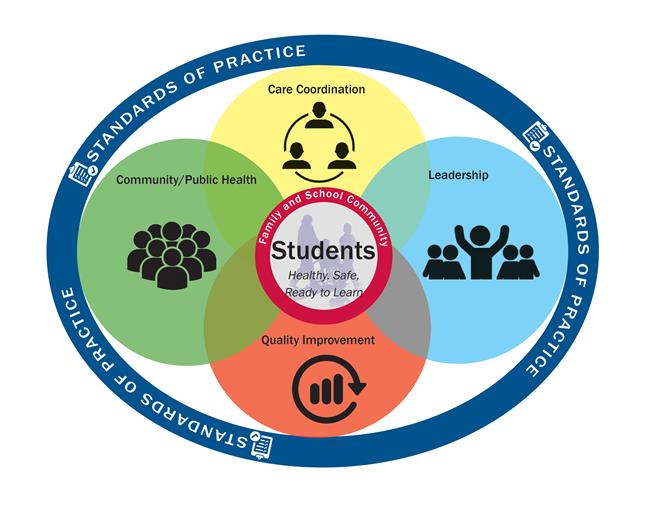Problem: Twenty-five percent of U.S. schools don’t have one.

Students arrive at school with health concerns that potentially lessen their educational attainment. School nurses have the expertise needed to help address those concerns.
 I remember that first day of school—my first day as a school nurse. The buzzing sound of students—connecting and conversing—followed me up the long flight of stairs and into the high school. At that point, I had been a nurse for 14 years in various community settings, including home care and hospice. Now another community was calling for my nursing knowledge and the skills I had honed in client-centered environments. I would also need the humility required when entering a new culture.
I remember that first day of school—my first day as a school nurse. The buzzing sound of students—connecting and conversing—followed me up the long flight of stairs and into the high school. At that point, I had been a nurse for 14 years in various community settings, including home care and hospice. Now another community was calling for my nursing knowledge and the skills I had honed in client-centered environments. I would also need the humility required when entering a new culture.
In delivering school health services, I worked with students with chronic health conditions, limited or no health insurance, and mental health issues, as well as insecure housing and food resources. I learned to assess students—individually and as a population—for strengths and barriers to their health, safety, learning, and well-being.
From then on, my desire to see students thrive and grow in all aspects of their lives determined my career path. From working directly with students, I moved to the state level, where I had the opportunity to influence the health and well-being of many more students. In tandem with my job as a health services specialist in state education, I engaged in volunteer work as a member of the National Association of School Nurses (NASN). When I became executive director of that organization, my passion for the health and well-being of students converged with my commitment to advance school nursing practice.
Student health today
Many students have health concerns that need to be managed during the school day. Children are experiencing increased anxiety and depression. One in four students has a chronic health condition. From 2017 to 2018, student use of e-cigarettes rose by 78%. Chronic absenteeism begins as early as kindergarten.
When elementary or secondary students miss 18 or more school days a year, it adversely affects their learning, engagement, and graduation. Absenteeism tends to be health-related, and home and community situations that impede health and learning—social determinants of health—are contributing factors. To help students attain educationally, schools increasingly focus on the needs of the whole child.
School nurses essential
School nurses coordinate care for students with acute as well as chronic health conditions. For the former, think of the student whose leg is in a cast for six weeks. The school nurse helps him or her develop a plan for health and safety in the school building. An example of the latter is a student who is diagnosed with Type 1 diabetes on a Thursday and is back in school the following Monday. The school nurse communicates with the student, family, and healthcare providers, including a specialist, to develop a plan that enables the student to thrive in school and prepares staff to handle an emergency.
To enable students to receive immunizations required for school entry, school nurses collaborate with local health departments to provide school-located vaccination clinics. Disease prevention and health promotion activities by school nurses help protect the entire student body. Linking with local agencies, school nurses assist students and their families in accessing healthcare and other resources for student well-being.
School nurses lead in promoting student and school health. When recess occurs before lunch, they advocate with administrators to ensure that elementary students have sufficient time to wash their hands before eating. School nurses join education teams to develop improvement plans that promote safe and supportive learning environments. As a growing number of states seek reimbursement for health services, school nurses participate in random moment time studies.
For optimal student health and to promote learning, school nurses provide both population-based and individual care. In 2016, NASN published a framework for school nursing practice that reflects the care needed for students today and in the future. Depicted graphically, the student-centered framework consists of overlapping circles labeled care coordination, community/public health, leadership, and quality improvement. Encompassing all of them is another circle labeled “standards of practice.”
School nurses practice within the limits set forth by state boards of nursing. These standards of professional practice highlight areas of competency in applying the nursing process. These practices are evidence-based. Click here to view larger image.
Click here to view larger image.
Data driven
To understand the effectiveness of their practices and interventions, school nurses collect, analyze, and use school health data. In accordance with state and local laws and policies, school nurses report student health trends from de-identified aggregate data. In addition to guiding the nurses’ own practices, the trends and other data points that emerge from these evaluations inform regulatory agencies about health and education outcomes for student populations and individual students.
Students arrive at school with health concerns—behavioral, environmental, mental, and physical—that potentially lessen their educational attainment. School nurses have the child health expertise needed to help address those concerns. Placing nurses in educational settings with students is an important investment. The health and well-being of students improve, which positively affects learning readiness. Parents and guardians are able to focus better on their work, knowing that the children they care for are healthy, safe, and ready to learn. As a community’s culture of health improves, the community thrives.
Twenty-five percent of schools across the United States do not employ a nurse, and where they do provide nurses, disparities exist. School nurses make a positive difference for students and their school communities. Every student deserves a school nurse! RNL
Donna Mazyck, MS, RN, NCSN, CAE, is executive director of the National Association of School Nurses.